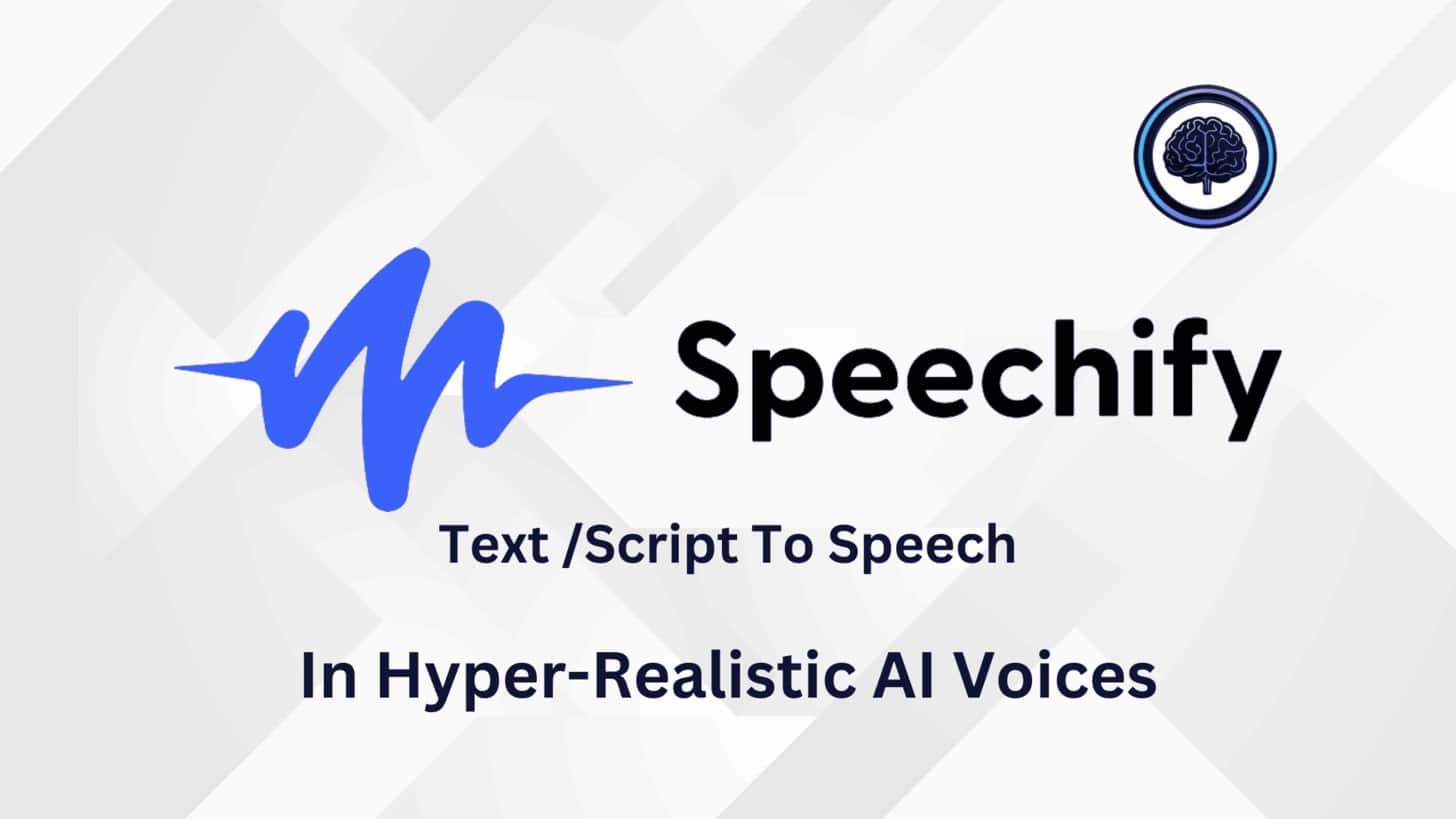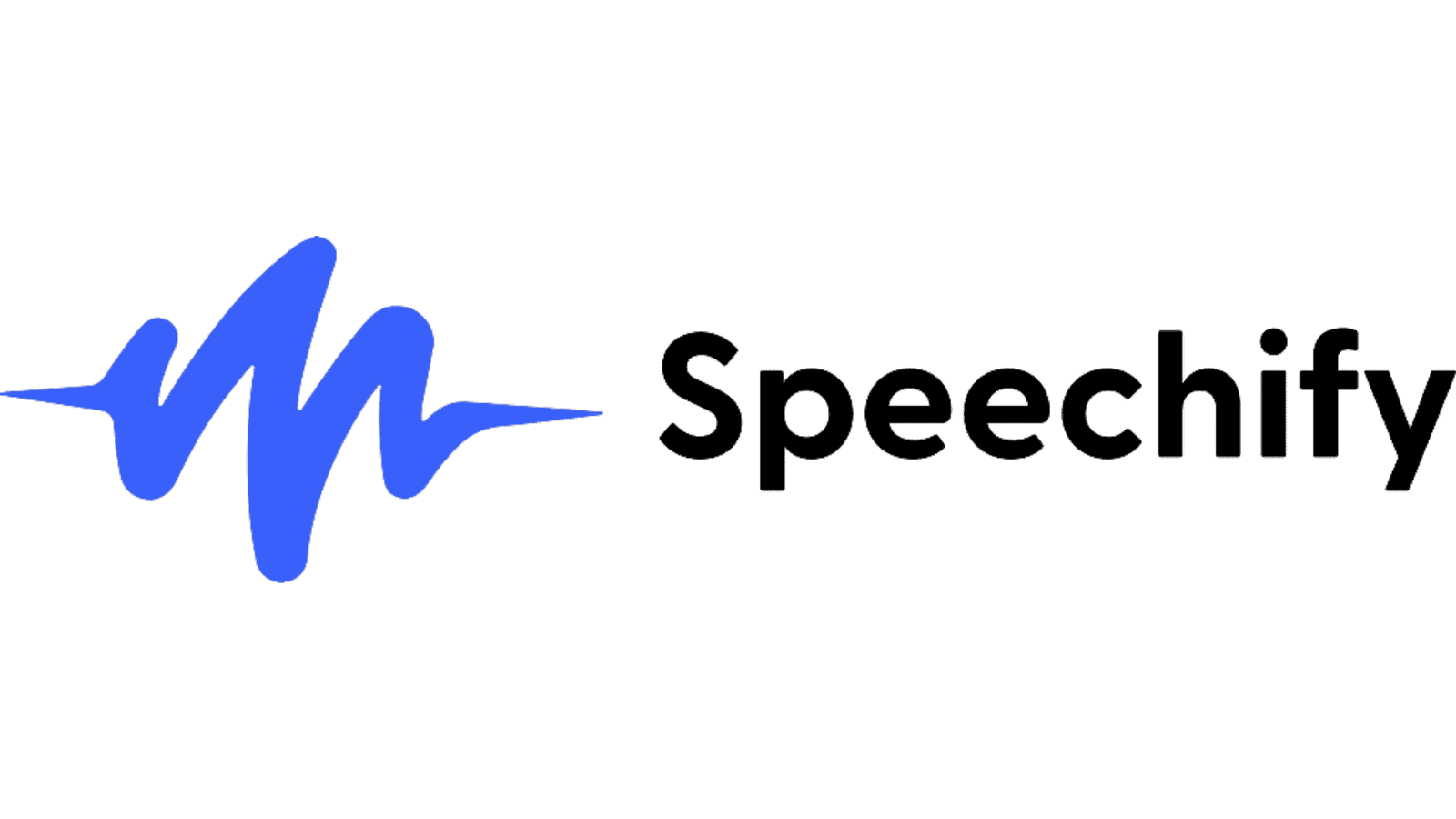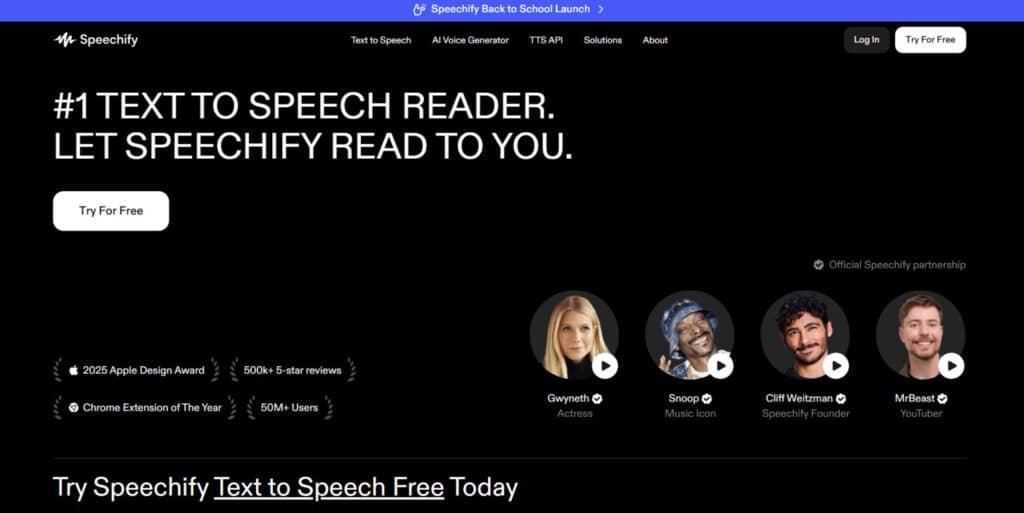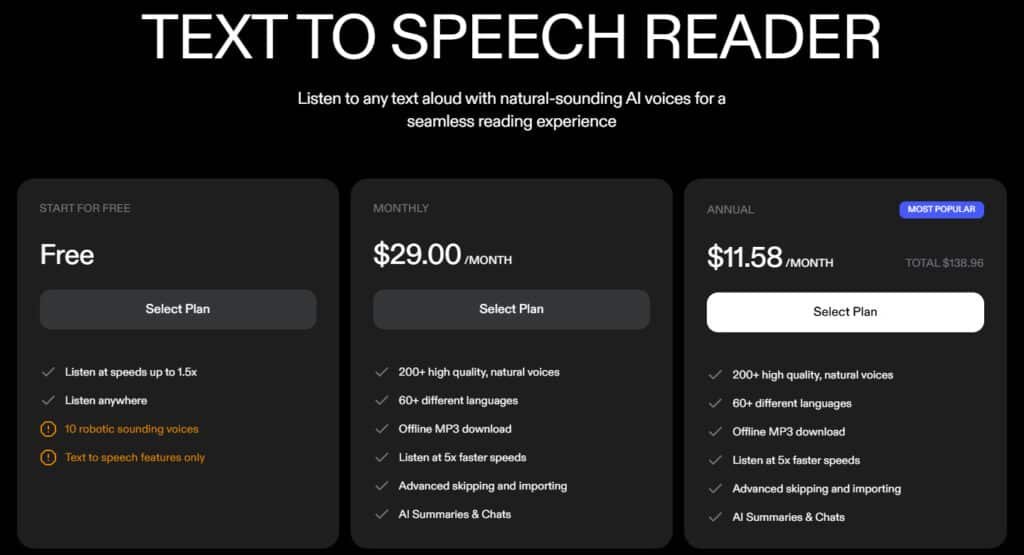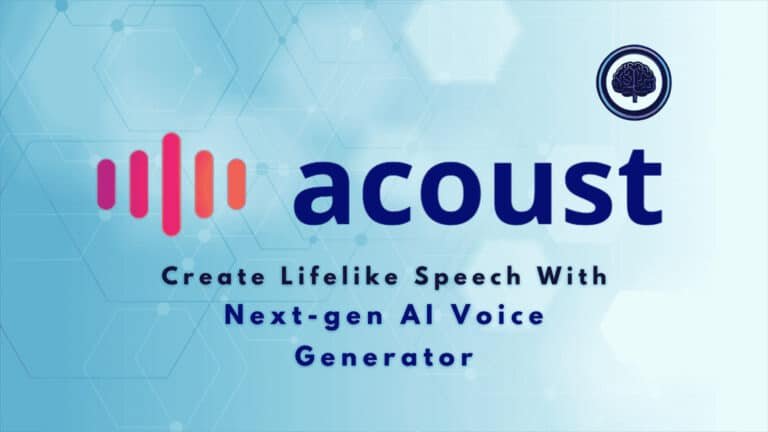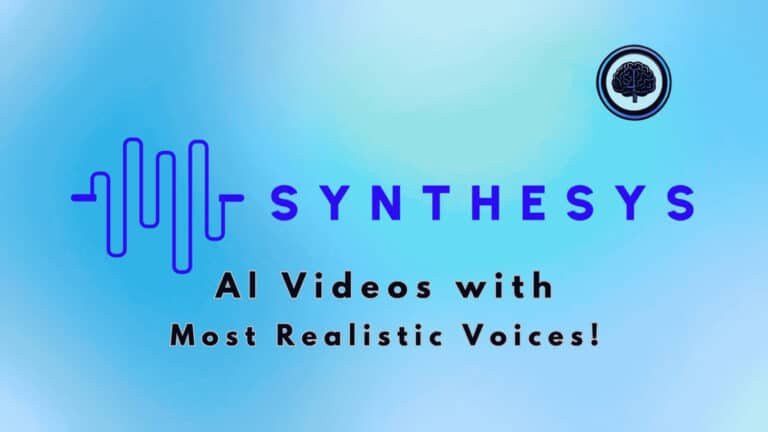You have long documents, emails, and web articles to absorb, but time and focus are scarce. Reading on screen strains your eyes and slows workflow.
That backlog turns into stress—important facts slip through the cracks, multitasking kills comprehension, and long commutes become wasted minutes. You want fast, reliable audio that sounds natural and keeps pace with your day.
I tested a leading text-to-speech app across web, macOS, iOS, Android, and Chrome/Edge/Safari extensions to see how it solves this. It converts text, files, and documents into narrated audio with celebrity voice options (yes, including Mr. Beast), OCR, AI summaries, and speed up to 900 WPM with word highlighting.
I’ll be candid: the listening UX and cross-platform reach stand out, while price and complex layout handling have limits. This article is a hands-on review of real workflows—emails, PDFs, Google Docs—so you get practical pros and cons. Let’s dive in.
Key Takeaways: Speechify Review
- Converts web pages, docs, and files into natural audio—great for busy readers and multitaskers.
- Cross-platform support (no dedicated Windows app) and celebrity voices add polish and fun.
- Top features: fast playback (up to 900 WPM), OCR, AI summaries, and MP3 exports (with limits).
- Pricing tiers: free plan to try, premium around $29/mo or ~$139/yr with a short trial.
- Best for students, professionals, researchers, book lovers, and neurodiverse users seeking efficiency.
Speechify Review: An Overview
Raamish’s Take
Speechify delivers a top-notch text-to-speech (TTS) experience, turning any text into natural-sounding audio with over 200 voices across 60+ languages.
I find its versatility impressive—perfect for multitasking like listening to emails or books while driving or cooking.
The app’s AI summaries and scan-to-listen feature save time, letting you snap a page and hear it instantly. With a Chrome Extension and apps for iOS, Android, and more, it’s easy to use anywhere.
Celebrities like Gwyneth Paltrow and Snoop Dogg endorse it, and its 2025 Apple Design Award shows its quality.
Security is a plus—no data training—and it offers voice cloning for personalized audio. Teams at Forbes and CBS feature it, proving its reliability. For busy pros or students, it cuts reading time with speeds up to 4.5x.
Overall, Speechify is a practical tool for hands-free learning or work, backed by a huge user base of 50M+.
Introduction to Speechify: Where It Fits in Today’s AI Reading Landscape
I tested the platform across devices to see whether it really makes reading faster and more accessible. The tool was created by Cliff Weitzman with a clear mission: remove barriers for people with dyslexia, ADHD, and heavy workloads.
It’s not just a reader—it highlights text, speeds playback, and adds simple AI analysis so you digest content faster. The company supports over 20 languages and offers celebrity voice options (Snoop Dogg, Mr. Beast, Gwyneth Paltrow) to keep long sessions engaging.
The app and browser extensions (Chrome/Edge/Safari) transform websites, Google Docs, PDFs, and emails into narrations without switching tools. That makes it useful for students (Canvas), researchers, executives, and avid readers.
Daily listening goals (up to 15 minutes) help build a habit and save time. Compared to basic OS readers, this product layers better voices, smarter controls, and in-place AI help across the places you already read.
Quick at-a-glance comparison
| Feature | Benefit | Typical Users | Where it works |
|---|---|---|---|
| High-quality voices | More pleasant listening | Students, commuters | Web, mobile, Mac |
| Highlight + speed control | Faster comprehension | Researchers, pros | Docs, PDFs, emails |
| 20+ languages | Multilingual access | International teams | Browser extensions |
| Daily goals | Consistent learning | Habit builders | All platforms |
What is Speechify?
I tested how the app turns long text into clean, listenable audio across my devices.
This speech app is a text-to-speech product that converts the text you already read—web pages, PDFs, Google Docs, and emails—into natural audio. It pulls content from local uploads, web links, Google Drive, Dropbox, and Canvas so you can listen anywhere.
How it works across devices
I use the web app for long sessions, the Chrome extension for on-site reading, and the mobile app on commutes. Everything syncs to one account, so progress and libraries follow you across macOS, iOS, Android, and browser extensions (Chrome/Edge/Safari).
Who benefits most
- Students: Canvas support and AI summaries speed study time.
- Professionals: Fast triage of reports and long emails.
- Book lovers: Turn online books into audiobooks.
- Neurodiverse users: Word highlighting plus audio improves focus.
The reader highlights words, auto-scrolls, and skips headers or URLs for cleaner narration. PDFs offer search, thumbnails, zoom, and MP3 export limits. The built-in AI “Ask” panel summarizes or answers questions, and you can listen to AI replies.
“Turning dense documents into audio saved me time on commutes and during chores.”
| Platform | Inputs | Key features |
|---|---|---|
| Web / Mac | Paste, links, Drive | Full reader, AI Ask, MP3 export |
| Mobile apps | Uploads, camera scan | Offline listen, sync, dark mode |
| Browser extensions | Page capture | In-place play, skip headers |
Note: There’s no native Windows desktop app—on PC you rely on the web app and extensions, which covered most workflows in my testing. Also, the Studio version adds creator tools (voice-overs, timelines, music) if you produce content rather than just consume it.
Best Features of Speechify
What stands out are practical, time-saving features you actually use every day. I focused on tools that help you turn long text into clean, listenable audio and keep your workflow moving.
1. Extensive Voice Library for Text-to-Speech
Speechify offers an extensive library of over 200 lifelike AI voices, making it a standout feature in the text speech market. These voices sound natural and human-like, drawing from advanced AI technology to deliver clear audio output. Users can select from a wide range, including options for different accents and tones, which enhances the overall listening experience.
This feature helps readers searching for reliable text speech solutions by providing versatile audio options that fit various needs, such as professional presentations or casual listening. For instance, professionals can use speechify to create engaging content without hiring voice actors, saving time and costs.
According to user reviews, this library boosts accessibility, allowing individuals with visual impairments to consume information effortlessly. The service integrates seamlessly, ensuring high-quality playback across devices.
In practice, this means quicker content creation for educators or marketers. By choosing the right voice, users improve comprehension rates, as studies from the International Dyslexia Association show that natural-sounding audio increases retention by up to 25%.
This feature of speechify positions it as a top choice for those evaluating speechify reviews.
2. Multilingual Language Support (Voice Dubbing)
One key feature among the features speechify provides is support for over 60 languages, including Spanish, Portuguese, German, and French. This broad coverage ensures that speechify can handle global content, from business documents to international news, without language barriers.
For readers intent on finding a multilingual service, this helps by enabling seamless translation and narration in native tongues, which is crucial for language learners or expatriates.
It allows users to use speechify for studying foreign books or reports, promoting better understanding and cultural immersion. Reviews highlight how this service reduces the need for multiple apps, streamlining workflows.
Real-world benefits include enhanced productivity for international teams; a case study from a European firm showed a 30% faster onboarding process using speechify‘s language tools. This feature makes speechify a versatile service for diverse audiences seeking efficient text speech options.
3. Adjustable Playback Speeds
Speechify excels with adjustable playback speeds up to 5x faster than normal reading, a core feature that lets users control their pace. This includes options from 0.5x for detailed listening to 4.5x for rapid reviews, ideal for busy schedules.
Searchers looking for productivity tools will find this feature helpful as it saves up to 9 hours weekly, according to aggregated speechify reviews. Commuters or students can use speechify to cover more material quickly, like scanning through lengthy books or articles without losing key details. The service adapts to individual preferences, improving focus during multitasking.
Evidence from cognitive research in the Journal of Applied Psychology indicates that controlled speeds enhance memory recall by 20%. This makes speechify read a practical choice for professionals aiming to balance workloads efficiently.
3. AI-Powered Summaries
The AI-powered summaries feature in speechify generates instant takeaways from any text, condensing long reads into concise overviews. This service processes content in seconds, highlighting main points for quick reference.
For users searching for time-saving aids, this helps by allowing focus on essentials, perfect for executives reviewing reports or students prepping for exams. It encourages use speechify for deeper analysis without full reads, as noted in positive reviews. This feature supports better decision-making in fast-paced environments.
A study by Gartner reports that summary tools like this cut information overload by 40%, aiding knowledge workers. As a reliable service, speechify integrates this seamlessly, elevating its value in daily routines.
4. Scan and Listen Functionality
Speechify‘s scan and listen feature uses the mobile app to capture images of pages, instantly converting them to spoken audio. This optical character recognition tool works on printed or digital text, bypassing manual input.
Readers with search intent for on-the-go solutions benefit as it enables hands-free access to physical books or notes, ideal for travelers or field workers. They can use speechify during commutes, turning downtime into learning opportunities. Reviews praise its accuracy, making it a trusted service for quick conversions.
Practical applications include educators scanning worksheets for auditory lessons, which boosts student engagement per UNESCO findings on multimodal learning. This text speech feature streamlines accessibility for all.
5. Voice Cloning Capabilities
Voice cloning stands out as a premium feature of speechify, where users upload short audio samples to create personalized AI voices. With permission, it replicates tones for custom narrations in emails, PDFs, or websites.
This aids searchers seeking creative tools by offering branded audio for podcasts or videos, reducing production expenses. Businesses can use speechify to maintain consistent speech in training materials, as reviews confirm its lifelike results. The service ensures ethical use, enhancing personalization.
Industry data from Adobe shows cloned voices increase listener trust by 35%. This feature empowers creators to scale content uniquely.
6. Speechify Studio for Content Creators
Speechify Studio introduces a suite for creators, featuring tools for voice-overs, dubs, and clones across 100+ languages and 13+ emotions. This service targets social media, ads, and podcasts with over 1,000 voice options.
For those reviewing creator platforms, it helps by simplifying video production, allowing quick emotional dubs that engage audiences. Users can use speechify to match content tones, streamlining edits. Reviews note its efficiency for TikTok or YouTube.
A Content Marketing Institute survey reveals such tools cut creation time by 50%, benefiting freelancers. This feature makes speechify indispensable for digital pros.
7. Developer API Integration
The Text-to-Speech API from speechify provides developers with natural voices, including cloning, streaming, and SSML controls. This feature supports instant integration for apps needing high-quality audio.
Search-intent users in tech will appreciate how it enables custom solutions, like embedding speechify in e-learning platforms. It helps scale services for millions, per documentation. Reviews commend its reliability.
API adoption stats from Postman indicate a 25% productivity gain for devs. This service fosters innovation in AI audio.
8. Cross-Platform Accessibility
Speechify ensures cross-platform access via iOS, Android, web, and browser extensions for Chrome and Edge. This feature allows seamless listening on any device, with offline MP3 downloads in paid plans.
It assists multitaskers by enabling uninterrupted sessions, from phones to desktops. Users can use speechify anywhere, as reviews affirm. The service covers all bases for mobile pros.
Accessibility reports from WebAIM show such versatility improves user satisfaction by 40%. Essential for on-demand books.
9. Additional Enhancements
Additional enhancements in speechify include unlimited storage, header skipping, and advanced importing for high-quality audio. These features round out the service for power users handling large files.
For comprehensive tool seekers, they help organize content efficiently, avoiding clutter. This supports long-form books or archives, with reviews highlighting ease. Use speechify for pro workflows.
User studies from Nielsen Norman Group note these tweaks enhance usability by 30%. A solid capstone feature.
10. Studio: creators’ version
The Studio version adds timelines, music, avatars (18), translations (60+ languages), and voice cloning in Studio Pro. Export to MP3/MP4 for podcasts and social clips.
| Feature | Benefit | Limit |
|---|---|---|
| Premium voices | More natural listening | No celebrity in MP3 |
| Speed & highlighting | Faster comprehension | High speed reduces retention |
| OCR & screenshots | Reads scans and images | Complex layouts may need manual fixes |
Pricing Plans of Speechify
Plans range from a basic free plan to a creator-focused Studio tier. Below I break costs, limits, and who should upgrade so you can decide fast.
Free plan: what’s included and limitations
The free plan gives core text-to-speech, limited voices, and a speed cap—good for testing extensions and quick articles. It’s ideal if you only need occasional listening and want to sample the mobile and browser experience before spending.
Premium plan: monthly vs. yearly pricing and value
The premium plan runs about $29 per month or roughly $139 per year (about $11.58 per month billed annually). Upgrading unlocks higher-quality voices, faster speeds, OCR/screenshot reading, AI summaries, and MP3 exports.
Value call: If you consume long articles, PDFs, or inbox content daily, premium version features often pay back the cost in saved time.
Studio plans: creator-focused features and cost considerations
Studio is separate and pricier—built for creators. Expect multi-track timelines, stock music, avatars, translations, and advanced editing. Voice cloning sits behind a Studio Pro tier and exports target MP3/MP4 for social or podcast use.
Free trial details, billing notes, and who should upgrade
There’s a 3-day free trial that requires a card and auto-renews unless canceled—set a reminder so you control the billing. Note export limits: celebrity voices may not be available in downloads, PDFs often cap around 60 minutes per file, and some accounts report yearly MP3 caps.
| Plan | Key perks | Typical user |
|---|---|---|
| Free | Basic TTS, limited voices | Casual readers |
| Premium | High-quality voices, OCR, AI, downloads | Students, professionals |
| Studio | Creator tools, timelines, voice cloning (Pro) | Podcasters, creators |
Use the trial to test mobile plus the browser extension. If both fit your daily flow, the upgrade usually makes sense for heavier listening and long-form content workflows.
Pros & Cons of Speechify
I’ve grouped what works best and the real drawbacks so you can decide quickly. Below are hands-on pros that improved my reading flow, followed by practical limits to watch for.
Pros at a glance
- Listening experience: natural voices (including celebrity tones) with synced highlighting that keeps text and audio aligned.
- Cross-platform: web, browser extensions, iOS/Android sync smoothly—great for commutes and multi-device workflows.
- Real helpers: OCR, screenshot reading, and the AI chat summarize dense content fast.
- Organization: library, folders, progress tracking, and daily goals help form a habit.
- Global reach: multi-language support suits bilingual teams and international users.
Cons to consider and when to look elsewhere
- Speed ceiling: the 900 WPM top speed is a headline feature but not practical for comprehension—treat it as a ceiling, not a target.
- Platform gap: no native Windows desktop app; web + extensions cover most needs but some environments prefer a true client.
- Cost vs. use: the premium plan can feel steep if you don’t listen many hours each week.
- Limits: MP3 downloads exclude celebrity voices and may be capped per file/account; AI help won’t replace a full research assistant.
- Edge cases: complex PDFs, code, or equations sometimes need manual cleanup or screenshot mode.
If those cons matter for your work—especially technical content or tight budgets—consider alternatives before committing to Speechify.
My overall takeaway from this short hands-on review: Speechify is a powerful app for many users, but not a one-size-fits-all solution.
How It Compares to Alternatives
Choosing the right reader means matching features to how you work. I tested several competitors and mapped each to common use cases so you can pick fast.
Quick take: some products focus on creator control, others on free basics or self-hosted privacy. Your choice depends on whether you need studio-grade output, browser convenience, or zero-cost options.
- NaturalReader: a solid consumer app with clear voices and desktop clients—good for straightforward text listening without AI chat.
- HeyGen: creator-focused—great for branded audio/video where timelines, music, and exports matter (compare against the Studio version).
- Murf AI: top-tier voice fidelity and cloning—best if ultra-realistic voices are your priority.
- Coqui TTS & GPT-SoVITS: open-source and self-hostable—ideal for teams who need privacy and cost control but can handle setup.
Built-in OS readers and open-source options
Free readers in Chrome, Edge, and macOS cover quick needs. They lack polished voices, AI chat, and cross-device libraries.
Which alternative fits which use case
Pick NaturalReader for simple desktop listening. Go to HeyGen, Murf, or ElevenLabs for studio-grade voice-overs. Choose Coqui or GPT-SoVITS if you must self-host.
| Product | Best for | Strength | When to choose |
|---|---|---|---|
| NaturalReader | Casual desktop listeners | Simple setup, clear voices | When you want easy local reading |
| HeyGen | Creators & brands | Timelines, music, exports | When studio control matters |
| Murf AI | Voice cloning & fidelity | Ultra-realistic voice models | When voice authenticity is top priority |
| Coqui / GPT-SoVITS | Developers & privacy-first teams | Self-hostable, flexible | When cost control and data ownership matter |
Where the app wins: everyday browser reading, screenshot OCR, the Ask AI panel, Canvas integrations, and a synced library across devices.
Where others win: studio features, native Windows clients, or self-hosted privacy. Balance budget, required features, and how much time you’ll save before choosing.
Case Study / Personal Experience
I spent a week integrating the app into a research-heavy workflow to see real gains in time, comprehension, and accessibility.
Real-world results: productivity, comprehension, and accessibility gains
Turning long articles and dense PDFs into audio reclaimed commute time and cut end-of-day eye strain. I finished more content without skimming; highlighted text plus a steady ~2x speed kept my focus on key points.
Inbox zero became realistic by using the chrome extension to listen to yesterday’s emails while making coffee. Listening let me triage faster than scrolling and flag items for deeper follow-up.
The built-in Ask AI saved rereads—five quick takeaways from a 20‑page report gave me a roadmap before I dove into methods. For messy PDFs, screenshot mode (lasso sections) fixed parsing issues and produced cleaner audio.
My experience across apps and devices
I used the web app for long sessions (AI Ask and PDF tools), the extension for site reading and social feeds, and the mobile app on commutes. Everything synced to one account, so progress percentages let me resume exactly where I left off.
- I exported MP3s for a flight—kept export caps in mind and skipped celebrity voices for downloads.
- Folders and progress tracking helped organize project documents and saved context switching.
- Pairing audio with highlighted words improved accessibility—useful for neurodiverse study styles and anyone with reading fatigue.
“It felt like the service read my queue so I could keep moving.”
Net result: measurable daily time saved and more completed long-form content without losing understanding—my practical experience shows how using speechify can change routine workflows.
Who Should Choose the Free Plan vs. Speechify Premium
Deciding whether to stick with the free tier or upgrade comes down to real-world use cases. Try the free plan first to test core playback, highlighting, and browser extensions on the sites you use most.
Test-drive scenarios for casual users
If you read a few web articles or emails a day, the free plan covers basic needs. It has limited features and lower top speeds, but it’s perfect for short sessions and quick checks.
Use the 3-day trial to upload a couple of PDFs and a Google Doc so you see how the app handles your real content and layout.
Power-user profiles that get the most from premium voices and features
Upgrade if you’re a student with weekly research papers, a pro triaging long reports, or a book lover queuing many hours. The premium plan adds higher-quality voices, OCR, AI summaries, and faster playback—helpful when speed and accuracy matter.
If you produce training or social clips, consider the Studio version for timelines, translations, and MP3/MP4 exports.
- Tip: If offline downloads matter, check per-file and annual caps before committing.
- Team idea: Mix free and premium accounts to match different users and control cost per month.
| Audience | Best fit | Why |
|---|---|---|
| Casual reader | Free plan | Short articles, emails, test extensions |
| Student / Researcher | Premium | OCR, AI summaries, long PDFs |
| Creator / Trainer | Studio | Timelines, exports, voice tools |
“Start free, load your real workflow, and upgrade only when the features add measurable time saved to your text-heavy days.”
Conclusion
Raamish’s Take
Speechify delivers a top-notch text-to-speech (TTS) experience, turning any text into natural-sounding audio with over 200 voices across 60+ languages.
I find its versatility impressive—perfect for multitasking like listening to emails or books while driving or cooking.
The app’s AI summaries and scan-to-listen feature save time, letting you snap a page and hear it instantly. With a Chrome Extension and apps for iOS, Android, and more, it’s easy to use anywhere.
Celebrities like Gwyneth Paltrow and Snoop Dogg endorse it, and its 2025 Apple Design Award shows its quality.
Security is a plus—no data training—and it offers voice cloning for personalized audio. Teams at Forbes and CBS feature it, proving its reliability. For busy pros or students, it cuts reading time with speeds up to 4.5x.
Overall, Speechify is a practical tool for hands-free learning or work, backed by a huge user base of 50M+.
My short verdict: Speechify turns text-heavy days into listenable ones, with a few trade-offs to note.
I found the cross-platform reader, celebrity voices, 20+ languages, OCR, AI “Ask” summaries, and the chrome extension make reading emails, documents, and files much faster. Highlighting plus adjustable speed (up to ~900 words per minute) helps you cover more content without losing comprehension.
Know the limits: no native Windows desktop client, download caps (and no celeb voices in MP3), and the premium version may feel pricey for light users. Try the free trial or free plan with your real queue—if it saves you hours, upgrade.
Install the extension, run the free trial, and test with a PDF or inbox batch. If you value hands-free learning and saved time, the premium plan often pays for itself.
FAQs: Cost ~ $29/mo or ~$139/yr for premium; 3-day free trial; downloads limited (~60 min/file; yearly caps reported); no Windows desktop app—use the web app and extensions; supports 20+ languages; reads PDFs and Google Docs; Ask AI answers document-based questions; consider privacy if you upload sensitive files.
Frequently Asked Questions
Who created this text-to-speech app and what’s the company’s mission?
The app was founded by a team focused on accessibility and productivity—aiming to turn written content into natural audio so people can learn and consume information faster. Their mission centers on helping users with reading challenges, busy professionals, and lifelong learners access text hands-free.
Who typically uses this reading tool and are there notable endorsements?
Users range from students and researchers to commuters, content creators, and people with dyslexia or visual impairments. The platform has attracted attention from creators and influencers, and it partners with well-known voices to expand its appeal.
How does the app work across devices and browsers?
It offers native apps for iOS and Android, a web player for desktops, a Mac app, and browser extensions for Chrome, Edge, and Safari—so you can read documents, web pages, emails, and social feeds seamlessly across devices.
What types of users benefit most from using this tool?
Students (for study materials), professionals (for emails and reports), book lovers (for long reads), and neurodiverse learners (for improved comprehension) get the most value. I find it especially helpful for multitasking and retaining information during commutes.
Are there natural-sounding or celebrity voices available?
Yes—premium voice options include highly natural tones and select celebrity-style voices that give an engaging listening experience. These premium voices are part of paid plans and boost realism and expressiveness.
Does it support multiple languages and accents?
The platform supports several languages and regional accents, making it useful for global users and language learners. Coverage varies by voice and plan.
How fast can the app read text and does it highlight as it goes?
Reading speed can be adjusted up to around 4.5–5x (some setups report near 900 words per minute) and it highlights text in sync with audio—helpful for follow-along and retention.
Can it read PDFs, scanned documents, or images?
Yes—the app includes OCR and screenshot-reading features so it can extract text from PDFs, scans, and on-page selections for playback.
Does it offer AI analysis like summaries or document chat?
Certain plans include AI tools to generate summaries, key takeaways, and conversational chat with your documents—useful for quick comprehension and research workflows.
Is there a way to organize content and track listening progress?
The app has a library system with folders, progress tracking, and daily listening goals to help you stay organized and measure usage over time.
Can I download audio files for offline listening?
Yes—premium tiers usually allow MP3 downloads so you can export voice-overs and listen without an internet connection.
What is the Studio offering and who benefits from it?
The Studio tier is creator-focused—offering pro voice-overs, timelines, background music, avatars, and translation features. It’s best for podcasters, video producers, and marketers who need polished audio assets.
What does the free plan include and what are its limits?
The free tier provides basic reading features, limited voices, and caps on speed, downloads, or monthly minutes. It’s great to test the core functionality but restricts premium voices and advanced AI tools.
How does the premium plan compare monthly vs. yearly?
Monthly billing gives flexibility but costs more per month; yearly subscriptions offer a discounted effective rate and unlock premium voices, downloads, faster speeds, and advanced features—better value if you use it daily.
Are there Studio-specific plans and how do costs scale?
Studio plans target creators and scale by usage—higher tiers unlock more export minutes, pro voices, and collaboration tools. Evaluate based on how many audio minutes and production features you need.
Is there a free trial and what should I watch for in billing?
Trial offers vary—some plans include short trials of premium voices or Studio features. Always check automatic renewal terms and cancellation windows to avoid unexpected charges.
What are the main advantages of using this app?
Pros include natural-sounding voices, cross-platform support, OCR for scanned docs, AI summaries, downloads for offline use, and creator tools for audio production—making it versatile for learning and content work.
What are its limitations or reasons to consider alternatives?
Cons can include subscription cost for top-tier voices, occasional voice artifacts depending on language, and feature gaps for specialized workflows. If you need fully customizable voice models or lower-cost bulk TTS, other platforms may fit better.
How does it stack up against alternatives like NaturalReader, ElevenLabs, or Murf?
It’s competitive on ease-of-use and cross-device sync. Alternatives may offer more advanced voice cloning, different pricing, or niche features—pick based on priorities: realism, customization, or budget.
Are built-in OS readers or open-source TTS a viable substitute?
Built-in readers (macOS, Chrome, Edge) are free and reliable for basic use. Open-source solutions give customization but require technical setup. The app sits between convenience and power—best when you want both.
What real-world gains can users expect—productivity and comprehension?
In my experience, daily listening speeds up content consumption, improves retention for long documents, and increases productivity by freeing up hands and eyes—especially during commute or chores.
How practical is the Chrome extension and mobile app in daily workflows?
The Chrome extension works well for web articles, Google Docs, and emails—it’s where I use it most. The mobile app is ideal for listening on the go and syncing across devices.
Who should stick with the free plan versus upgrade to premium?
Casual readers and trial users can stay on the free plan. Power users—students, professionals, and creators who need premium voices, downloads, AI summaries, or Studio features—should consider upgrading for real value.
Any tips for getting the best experience from the app?
Try different voices and speeds to find what helps comprehension. Use highlights and summaries for dense material. If you produce audio, test Studio features on a short project before committing to a higher plan.

